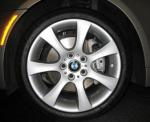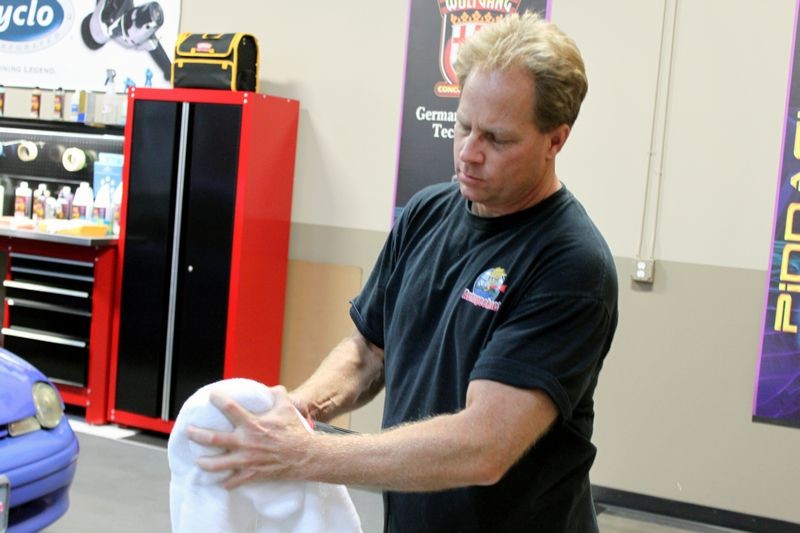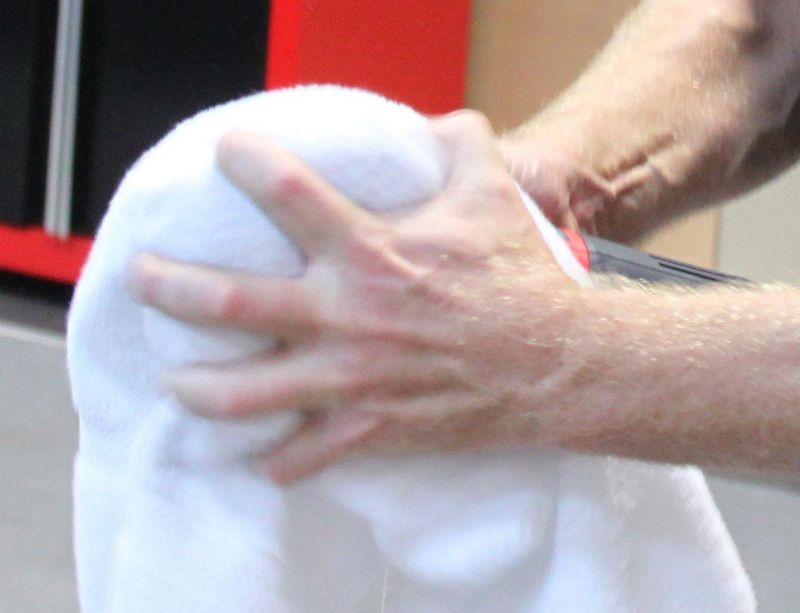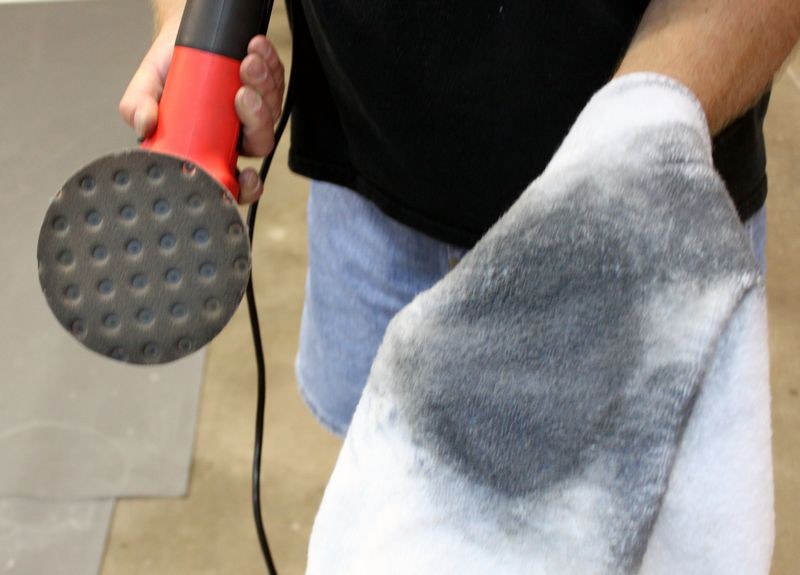 Thanks: 0
 Likes: 0
 Dislikes: 0
-
Why it's important to clean your pads often...
-
Super Member

Re: Why it's important to clean your pads often...
Hi Mike,
In keeping with your thread. How many orange correction pads do you normally use to correct a moderately swirled vehicle with a DA, provided you don't have a pad washer and use the on the fly cleaning method. How about white polishing pads afterward? I find that even using your on the fly method and a brush that a clean pad makes correction faster.
A pad washer seems like a nice option, but one can buy 10-20 pads for the price of the washer. Since I'm a hobbiest, I'm not likely to do more than one or two cars in a weekend, but I still think the washer is a cool tool.
Thanks
-
Super Member

Re: Why it's important to clean your pads often...
 Originally Posted by Kurt_s

Hi Mike,
In keeping with your thread. How many orange correction pads do you normally use to correct a moderately swirled vehicle with a DA, provided you don't have a pad washer and use the on the fly cleaning method. How about white polishing pads afterward? I find that even using your on the fly method and a brush that a clean pad makes correction faster.
A pad washer seems like a nice option, but one can buy 10-20 pads for the price of the washer. Since I'm a hobbiest, I'm not likely to do more than one or two cars in a weekend, but I still think the washer is a cool tool.
Thanks
Having a good supply of pads on hand is always a good idea. I clean my pads on the fly using a "modified" system that I created.
For the most part everyone here knows what a grit guard is. I cut down an old bucket about an inch higher than the grit guard so I have access to it with the pad while it's on the polisher.
I pour some solution in the bottom of the bucket then add just enough water so that it's just covering the grit guard. Place the pad on the grit guard then turn the unit on allowing it to scrub the pad while the solution dissolves the contaminates.
The grit guard is plastic and does vibrate during use so I don't know how long it'll last but it's working so far...
To dry the pad I place the pad in another bucket and spin it up letting centrifugal force assist me in drying.
While this may not be as slick as the commercially available pad washer available through Autogeek, for the most part it does a decent job.
The bottom line is, there are lots of options for us to try!

 BobbyG - 2004 Millennium Yellow Z06 Corvette BobbyG - 2004 Millennium Yellow Z06 Corvette
-
Re: Why it's important to clean your pads often...
 Originally Posted by Kurt_s

Hi Mike,
In keeping with your thread. How many orange correction pads do you normally use to correct a moderately swirled vehicle with a DA, provided you don't have a pad washer and use the on the fly cleaning method. How about white polishing pads afterward? I find that even using your on the fly method and a brush that a clean pad makes correction faster.
A pad washer seems like a nice option, but one can buy 10-20 pads for the price of the washer. Since I'm a hobbiest, I'm not likely to do more than one or two cars in a weekend, but I still think the washer is a cool tool.
Thanks
Hey Kurt,
I will eventually have enough pads to change after each panel. That would be awesome. However, I currently use about 6 orange pads per vehicle. 1 pad for every 2 panels. Same for white pads.
-
Junior Member

Re: Why it's important to clean your pads often...
 Originally Posted by BobbyG

Having a good supply of pads on hand is always a good idea. I clean my pads on the fly using a "modified" system that I created.
For the most part everyone here knows what a grit guard is. I cut down an old bucket about an inch higher than the grit guard so I have access to it with the pad while it's on the polisher.
I pour some solution in the bottom of the bucket then add just enough water so that it's just covering the grit guard. Place the pad on the grit guard then turn the unit on allowing it to scrub the pad while the solution dissolves the contaminates.
The grit guard is plastic and does vibrate during use so I don't know how long it'll last but it's working so far...
To dry the pad I place the pad in another bucket and spin it up letting centrifugal force assist me in drying.
While this may not be as slick as the commercially available pad washer available through Autogeek, for the most part it does a decent job.
The bottom line is, there are lots of options for us to try!
That's a neat idea, i never thought of cutting the bucket to do that 
-
Super Member

Re: Why it's important to clean your pads often...
 Originally Posted by BobbyG

Having a good supply of pads on hand is always a good idea. I clean my pads on the fly using a "modified" system that I created.
For the most part everyone here knows what a grit guard is. I cut down an old bucket about an inch higher than the grit guard so I have access to it with the pad while it's on the polisher.
I pour some solution in the bottom of the bucket then add just enough water so that it's just covering the grit guard. Place the pad on the grit guard then turn the unit on allowing it to scrub the pad while the solution dissolves the contaminates.
The grit guard is plastic and does vibrate during use so I don't know how long it'll last but it's working so far...
To dry the pad I place the pad in another bucket and spin it up letting centrifugal force assist me in drying.
While this may not be as slick as the commercially available pad washer available through Autogeek, for the most part it does a decent job.
The bottom line is, there are lots of options for us to try!
Bobby,
Now that is an interesting alternative to the pad washer for the time being. What's your cleaning solution? I've been working with a few 6.5" orange and 2 4" orange flats for correction, and I find that I sometimes need to stop and clean the pads even using the on-the-fly method.
I've already learned the frisbee trick when trying to spin out a pad without a bucket. 
 Originally Posted by 07 z-oh-6

Hey Kurt,
I will eventually have enough pads to change after each panel. That would be awesome. However, I currently use about 6 orange pads per vehicle. 1 pad for every 2 panels. Same for white pads.
Using clean pads certainly makes it go faster. Maybe I should have invested in more pads?
I decided to move down to 5.5" correcting pads anyway, so maybe I can get by with 3-4 orange and another grit guard if Bobby's method works. Perhaps the same for the whites.
I've also been thinking about moving away from CCS and into either flats or the Hydro-Techs since I'm going to use a smaller pad. What do you guys think of the flats, Hydro-tech or other?
The 6.5" CCS reds that I bought seem to be a waste of money. It just sucks up too much LSP so I use a 4" flat. Maybe a 5.5" would apply faster but the 4" doesn't take long and it is much easier to handle it by hand to get the tight spots.
Can I use the 6.5" reds for anything else other than LSP application? Maybe finish polishing, window buffing or with a paint cleaner?
Thanks for the suggestions!
-
Re: Why it's important to clean your pads often...
A method I have used with some success is to fill a bucket about 1/2 way with water/solution, and when it is time to clean the pad, hold the grit guard in one hand, while the other is holding the polisher running. You basically have to hold them sideways vs flat like in a normal pad washer, but if ran at a low enough rpm you won't get water flinging out if you just have the edges of the pad touching the water. Lift out for a brief second so it is now no longer in contact with water which helps dry it of, then let the grit guard fall to the bottom, turn the buffer face down, and spin it at speed to dry it off.
Works amazingly well and doesn't cost you a penny or another bucket, considering you already have a Grit Guard, which we all highly recommend to begin with.
-
Re: Why it's important to clean your pads often...
 Originally Posted by BobbyG

For the most part everyone here knows what a grit guard is. I cut down an old bucket about an inch higher than the grit guard so I have access to it with the pad while it's on the polisher.
Very creative Bobby... that's thinking outside the bucket...
Both the Grit Guard Pad Washer and the System 2000 Pad washer both have pumps that inject cleaning solution at the face of the pad as you run the polisher and that's a benefit that will be hard to duplicate without the pumps or the entire system but if you're method is working to clean the pads then like I always tell my son...
Something is better than nothing...
How about a few pictures?

-
Re: Why it's important to clean your pads often...
 Originally Posted by Kurt_s

Hi Mike,
In keeping with your thread. How many orange correction pads do you normally use to correct a moderately swirled vehicle with a DA, provided you don't have a pad washer and use the on the fly cleaning method. How about white polishing pads afterward? I find that even using your on the fly method and a brush that a clean pad makes correction faster.
I can't remember the last time I actively counted pads... suffice to say... more pads are better than less pads...
In a perfect world being able to switch to a clean dry pad for each panel and a couple for the larger panels like the hood and roof, (depending upon what you're working on), is the fastest way to get through the correction steps, which take the most amount of time.
Somewhere on this forum I think I wrote something on the topic of how many pads you need to buff out a car... just not sure where...
But more is better...
The pads don't have to be brand new, just clean and dry, so that would be more clean and dry used pads or clean and dry new pads.

-
Super Member

Re: Why it's important to clean your pads often...
 Originally Posted by Mike.Phillips@Autogeek

I can't remember the last time I actively counted pads... suffice to say... more pads are better than less pads...
In a perfect world being able to switch to a clean dry pad for each panel and a couple for the larger panels like the hood and roof, (depending upon what you're working on), is the fastest way to get through the correction steps, which take the most amount of time.
Somewhere on this forum I think I wrote something on the topic of how many pads you need to buff out a car... just not sure where...
But more is better...
The pads don't have to be brand new, just clean and dry, so that would be more clean and dry used pads or clean and dry new pads.

When I first bought my PC, 2 ea 6.5" orange, white and red CCS pads were recommended as a place to start. I have a picked up a few pads more along the way, but not enough.
The first time I corrected my car, I had to clean the orange pads a couple of times, on top of your "on-the-fly" method. I never felt that I needed as many white pads.
It sounds like 6 orange is a safe number if one doesn't want to clean pads mid-stream by hand. Maybe Bobby's method will save me a few dollars. I will probably pick up 3-4 whites as I move to 5.5" pads.
Any alternative uses for the 6.5" reds? I don't have a dog anymore for frisbee catch...
Similar Threads
-
By jmeyers278 in forum Auto Detailing 101
Replies: 10
Last Post: 11-23-2017, 09:56 AM
-
By Dan Tran in forum Auto Detailing 101
Replies: 6
Last Post: 10-28-2015, 06:54 AM
-
By swanicyouth in forum Auto Detailing 101
Replies: 14
Last Post: 09-01-2014, 09:16 PM
-
By jamores23 in forum Auto Detailing 101
Replies: 3
Last Post: 05-24-2012, 06:33 PM
-
By Zack01GC in forum Auto Detailing Tools and Accessories
Replies: 6
Last Post: 11-06-2007, 01:13 PM
 Members who have read this thread: 0
Members who have read this thread: 0
There are no members to list at the moment.
 Posting Permissions
Posting Permissions
- You may not post new threads
- You may not post replies
- You may not post attachments
- You may not edit your posts
-
Forum Rules
|
| S |
M |
T |
W |
T |
F |
S |
| 31 |
1
|
2
|
3
|
4
|
5
|
6
|
|
7
|
8
|
9
|
10
|
11
|
12
|
13
|
|
14
|
15
|
16
|
17
|
18
|
19
|
20
|
|
21
|
22
|
23
|
24
|
25
|
26
|
27
|
|
28
|
29
|
30
| 1 | 2 | 3 | 4 |
|













 Thanks:
Thanks:  Likes:
Likes:  Dislikes:
Dislikes: 





 Reply With Quote
Reply With Quote





Bookmarks